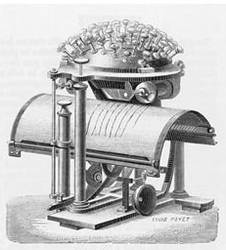The history of the invention of the writing ball
Rasmus Malling-Hansen most famous invention was the writing ball - the most finely crafted and impressive of the early typewriters. It was invented in 1865 and was first patented and entered production in 1870, and was the first commercially produced typewriter, in danish it was called the '''skrivekugle'''. The Hansen ball was a combination of stunning design and ergonomic innovations, but like most of the early 19th century typewriters, it did not allow the paper to be seen as it passed through the device.
Its distinctive feature was an arrangement of 52 keys on a large brass hemisphere, causing the machine to resemble a giant pin cushion. From the book ''Hvem er Skrivekuglens Opfinder'', written by Malling-Hansen's daughter Johanne Agerskov, we know how Malling-Hansen made experiments with a model of his writing ball made out of porselain. He tried out different placements of the letters on the keys, to work out the placement that lead to the fastest writing speed. He ended up placing the most frequently used letters to be touched by the fastest writing fingers, and also placed most of the vocals to the left and the consonants to the right. This together with the short pistons which went directly through the ball, made the writing speed of the writing ball very fast.
The first models typed on a paper attached to a cylinder, and included an electromagnetic escapement for the Ball, thus making Malling-Hansen's machine the first electric typewriter. He made several improvements on his invention throughout the 1870's and -80's, and already in 1871 several new models were built. On one of the new models the cylinder was replaced by a flat mechanical paper-frame. The electromagnetic battery was still used to move the paper along as the Ball typed upon it, and the design was so ingenious that few errors were possible. Malling-Hansen improved further on his design, and created a semi-cylindrical frame to hold one sheet of paper. This best known model was first patented in 1875, and now the battery was replaced by a mecanical escapement. All these improvements made for a simpler and more compact writing apparatus.
Friedrich Nietzsche(who called it a schreibkugel) was the most famous user of the writing ball. Unfortunately his writing ball was damaged during the transport, and when Nietzche wanted to get it repaired, he turned to a mecanic who had no experience with typing machines, and he made further damages to the writing ball. This all lead to great problems for Nietzche's use of the writing ball, and he was never really satisfied with his typewriter. But as we know today, this was not because of bad quality of the writng ball, but due to damages.
The writing ball was exhibited at several exhibitions throughout the 1870's - at the first annual Kensington Exhibition in London in 1871, at the Scandinavian Art-, Agricultural- and Industrial Exhibition in Copenhagen in 1872, at the World Exhibition in Vienna in 1873, at the Philadelphia Centennial in 1876, at the Paris exhibition, or Exposition Universelle in 1878 and at The Scandinavian Exhibition in Copenhagen in 1888. At all but one of the exhibitions it won the First Price award. (In the Kensington Exhibitions in London the wanted to avoide the competition-aspect, and no medals were assigned.) Malling-Hansen also received many orders and merit medals from all over Europe, and the patents were sold to several countries for production.
It's known that the writing ball was still in use in offices in London as late as in 1909 and some sources claim it was actually in use as late as in the 1970's in Dutch courts. But these were only the exceptions - unfortunately the writing ball never became the commercial success it's inventor had hoped for, and one maybe would expect, considering the great attention and words of praise that his machine received in the beginning. Instead it was the American machines that won the market, and the first "dangerous" competitor of the writing ball was the Sholes&Glidden machine which E. Remington and Sons started to produce in 1873. It was invented and patented in 1868 by Sholes, Glidden and Yost, but their patent was sold to the rich investor James Densmore, who invested a large amount of money to improve the original model, where it's inventors had reached as far as they thought they could. In 1878 both the Remington machine and the writing ball was exhibited at the World Exhibition in Paris, and the judges and the journalists judged the writing ball to be of a far better quality than the Remington typewriter, and it was also cheaper!
Why are we then not writing on round keyboards today, one might ask? It's due to a very simple matter, I think: Lack of money! Where James Densmore invested tens and tens of thousand dollars in "his" typewriter, Malling-Hansen never managed to arise the interest of "heavy" investors in Europe. The Remington machine had obviously large benefits from the Remington factorys already existing agents and stores, and their typewriter could be exhibited and purchased in every Remington store throughout the world. The writing ball could only be seen in a very few places, and every machine had to be ordered singly from Denmark.
Today intact writing balls are very sought after among collectors and museums, and are priced very high - writing balls in good condition are reported sold for more than 100.000,- Euro!
Oslo 27.10.06
Sverre Avnskog

- A computer artwork inspired by the 1878 model of the writing ball. It is created by Mike Maier, who has also created some beautiful interior pictures inspired by the writing ball. Mike has simplified the model just a little and not included all the details. But all the same - it's a lovely piece of work! Copyright: Mike Maier Website: www.mjmaier.com






